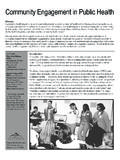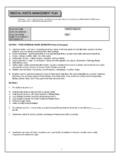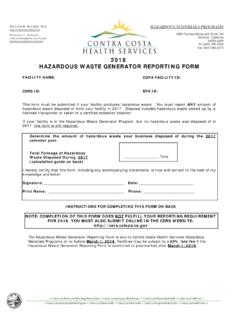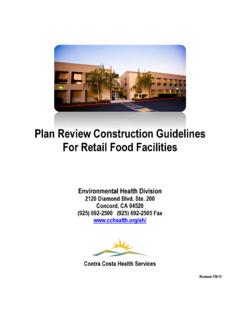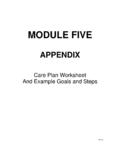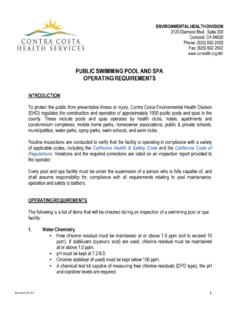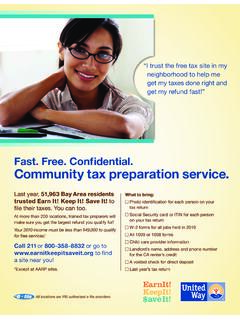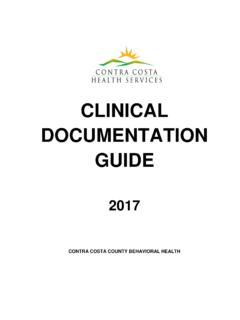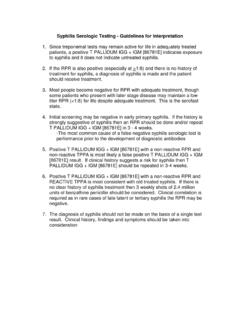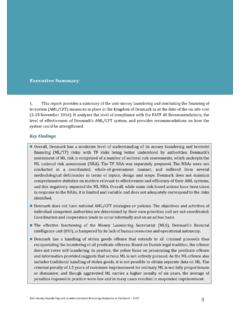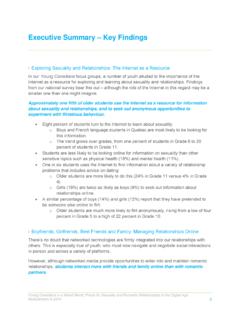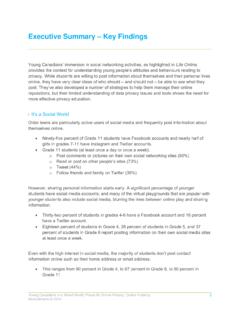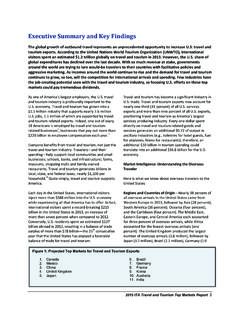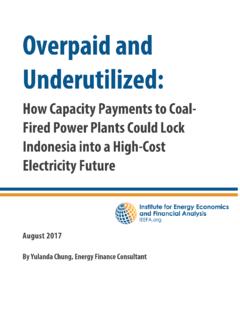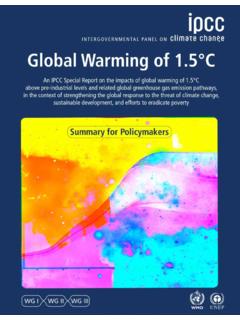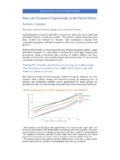Transcription of Executive Summary - Contra Costa Health Services
1 5 Executive Summary This Summary highlights key findings from the 2010 report Community Health Indicators for Contra Costa county . This report was prepared by Contra Costa Health Services Community Health Assessment, Planning and Evaluation Unit for the Hospital Council of Northern and Central California and is intended to help Health service providers and the broader community understand the Health status and Health issues of the communities within Contra Costa and to guide local efforts to develop programs, strategies and policies to improve the Health of the county . This report provides an update to the 2007 report Community Health Indicators for Contra Costa county . It also includes several new features to help explore new topics and present others through a different lens: a new section that illustrates important Health disparities among different populations in the county and some of the underlying social determinants of these unfair differences in Health , other new sections on breastfeeding and domestic violence, and maps illustrating hospitalizations for non-fatal injuries and childhood asthma.
2 Below are some of the key findings from the report. Key FindingsDEMOGRAPHICSFrom 2005 2007, Contra Costa had more than 1,011,000 residents. The racial/ethnic composition of the county s population was white, Hispanic, Asian/Pacific Islander and African American. Between 2005-2007, there was an average of 13,398 births per year: to Hispanic moth-ers, to white mothers, to Asian/Pacific Islander mothers and to African American mothers. With more births to Hispanic mothers than any other racial/ethnic group, Hispanics are the fastest growing ethnic group in the Costa compares favorably with the state and nation on income and education, but looking at the county as a whole masks the vast differences in experience of the county s more than 1 million residents.
3 The median household income for Contra Costa in 2009 was $75,139 compared to just $58,931 in California and $50,221 in the United States. Similarly, Contra Costa had a greater percent-age of college graduates ( ) than the state ( ) or nation ( ) in 2009. Within the county , however, distribution of income and education was not uniform and this unequal distribution was echoed in disparities in Health outcomes. Health INEQUITIESC ontra Costa residents of low-income and poorly educated communities, and African American residents experience worse Health outcomes and dramatically lower life expectancy. Poverty was associated with poorer Health status and shorter life expectancy among Contra Costa residents.
4 A child born in a low-poverty area in 2000 could expect to live more than six years longer than a child born in a high-poverty area. Life expectancy in low-poverty areas was years compared to years in high-poverty educational attainment was associated with poorer Health and shorter life expectancy among Contra Costa residents. A child born in a high-education area in Contra Costa in 2000 could expect to live more than seven years longer than a child born in a low-education area. Life expectancy in high-education areas in the county was years compared to years in low-education American residents in Contra Costa had a shorter life expectancy than other county residents and were at greater risk for a number of poor Health outcomes throughout the life course.
5 African Americans in Contra Costa had a shorter life expectancy ( years) than any other racial/ethnic group in the county . An Asian/Pacific Islander or Hispanic baby born between 2005 and 2007 in Contra Costa could expect to live more than five years longer than a white baby and more than 12 years longer than an African American baby born at the same time. African American residents also had significantly higher rates of death than the county overall for a number of specific causes of death, including heart disease, cancers (all types combined as well as female breast, colorectal, lung and prostate cancers), diabetes, stroke, homicide, unintentional injuries, fetal and infant deaths, and HIV disease.
6 Compared to county residents overall, African Americans also experienced higher rates of new cases of colorectal, lung and prostate cancer, new cases of HIV and AIDS, hospitalization for non-fatal assault and self-inflicted injuries, low birth weight infants and teen births, and a higher percent overweight and obese OF DEATH AND DISABILITYMost deaths in Contra Costa were from chronic diseases. Cancer and heart disease were the top two causes of death in the county , accounting for of all deaths, followed by stroke ( ). Lung, colorectal and breast cancer were the leading causes of cancer death. Smoking and obesity, key risk factors for heart disease, stroke and cancer, continue to plague local residents.
7 The prevalence of current smoking was among adults in Contra Costa . More than half of adults ( ) and more than one-quarter ( ) of fifth-graders in the county were overweight or obese. A greater percentage of fifth-graders in the Antioch, West Contra Costa and Pittsburg unified school districts were overweight or obese compared to fifth-graders Contra Costa s top 10 leading causes of death, only homicide was more likely in the county than the state. Among younger residents (ages 15 24), unintentional injury, homicide and suicide are the three leading causes of death. People ages 15 24 were also more likely to be hospitalized for non-fatal assaults and self-inflicted injuries than other age groups.
8 Because deaths from these causes affect young people disproportionately, they have a greater impact on years of potential life lost. Large numbers and high rates of homicide threatened the Health and well-being of some communities more than others, including Richmond, Antioch, Pittsburg and San Pablo. Unintentional injury is an important Health issue for residents of all ages. Unintentional injury was one of the top three leading causes of death among residents ages one to 54 years. Residents ages 65 years and older were most likely to be hospitalized and die from unintentional injury. The unintentional injury death rate was higher for residents of Martinez and Walnut Creek than for residents of the county overall, driven by poisonings and continues to spread in Contra Costa .
9 Most HIV and AIDS cases were among men; men who have sex with men (MSM) accounted for almost three-quarters ( ) of transmissions among men. Almost half of the HIV cases ( ) were diagnosed among whites, but African Americans had higher rates of new HIV and AIDS cases than the county overall. Among people diagnosed with AIDS, residents of Richmond, Concord, Antioch and Walnut Creek accounted for more than half ( ) of AIDS cases. Richmond residents were more likely to be diagnosed with AIDS than county residents as a whole. People ages 25-44 years were most likely to be diagnosed with HIV and AIDS. Rates of chlamydia and gonorrhea were also higher among younger people. Residents ages 15 29 years had higher rates of chlamydia and those ages 15-34 had higher rates of gonorrhea than county residents SOURCES AND LIMITATIONS The information presented in this report helps provide a picture of the Health of the county .
10 It includes data that is available and traditionally measured by Health departments. But it is important to be aware of the limitations of data presented and to understand what is missing. Contra Costa is a large county with wide differences in the Health of its diverse communities. A Health indicator for the county as a whole, such as all-cause mortality, is an average of extremes and does little to help us identify problems in specific communities or evaluate successes of targeted programs. When available, data in this report is presented at a sub- county level, by age, race/ethnicity and community to provide information about the distribution of key Health issues among different populations in the county .
